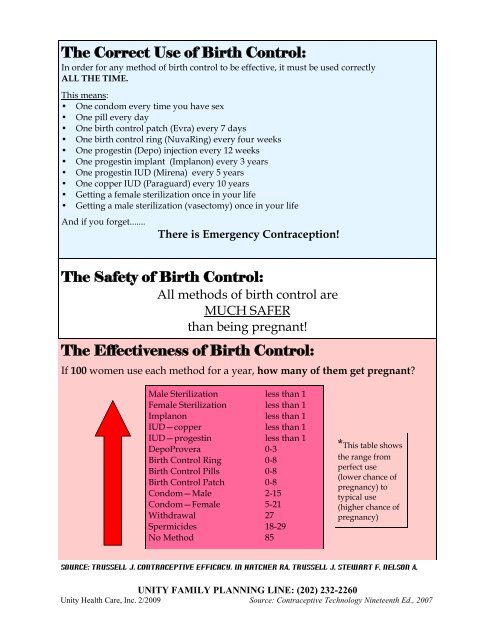The Correct Use of Birth Control: The ... - Unity Health Care
The Correct Use of Birth Control: The ... - Unity Health Care
The Correct Use of Birth Control: The ... - Unity Health Care
You also want an ePaper? Increase the reach of your titles
YUMPU automatically turns print PDFs into web optimized ePapers that Google loves.
<strong>The</strong> <strong>Correct</strong> <strong>Use</strong> <strong>of</strong> <strong>Birth</strong> <strong>Control</strong>:<br />
In order for any method <strong>of</strong> birth control to be effective, it must be used correctly<br />
ALL THE TIME.<br />
This means:<br />
• One condom every time you have sex<br />
• One pill every day<br />
• One birth control patch (Evra) every 7 days<br />
• One birth control ring (NuvaRing) every four weeks<br />
• One progestin (Depo) injection every 12 weeks<br />
• One progestin implant (Implanon) every 3 years<br />
• One progestin IUD (Mirena) every 5 years<br />
• One copper IUD (Paraguard) every 10 years<br />
• Getting a female sterilization once in your life<br />
• Getting a male sterilization (vasectomy) once in your life<br />
And if you forget.......<br />
<strong>The</strong>re is Emergency Contraception!<br />
<strong>The</strong> Safety <strong>of</strong> <strong>Birth</strong> <strong>Control</strong>:<br />
All methods <strong>of</strong> birth control are<br />
MUCH SAFER<br />
than being pregnant!<br />
<strong>The</strong> Effectiveness <strong>of</strong> <strong>Birth</strong> <strong>Control</strong>:<br />
If 100 women use each method for a year, how many <strong>of</strong> them get pregnant?<br />
Male Sterilization less than 1<br />
Female Sterilization less than 1<br />
Implanon less than 1<br />
IUD—copper less than 1<br />
IUD—progestin less than 1<br />
DepoProvera 0-3<br />
<strong>Birth</strong> <strong>Control</strong> Ring 0-8<br />
<strong>Birth</strong> <strong>Control</strong> Pills 0-8<br />
<strong>Birth</strong> <strong>Control</strong> Patch 0-8<br />
Condom—Male 2-15<br />
Condom—Female 5-21<br />
Withdrawal 27<br />
Spermicides 18-29<br />
No Method 85<br />
*This table shows<br />
the range from<br />
perfect use<br />
(lower chance <strong>of</strong><br />
pregnancy) to<br />
typical use<br />
(higher chance <strong>of</strong><br />
pregnancy)<br />
Source: Trussell J. Contraceptive efficacy. In Hatcher RA, Trussell J, Stewart F, Nelson A,<br />
UNITY FAMILY PLANNING LINE: (202) 232-2260<br />
<strong>Unity</strong> <strong>Health</strong> <strong>Care</strong>, Inc. 2/2009 Source: Contraceptive Technology Nineteenth Ed., 2007
Intrauterine Contraception (Paraguard® and Mirena®)<br />
How it works:<br />
Intrauterine contraception (“intrauterine device” or “IUD”) keeps the man’s sperm from meeting<br />
the woman’s egg. IUDs have either copper or progestin (birth control hormone) in them to<br />
help them work.<br />
<strong>The</strong> IUD is inserted into the uterus by a provider during a routine <strong>of</strong>fice visit.<br />
Effectiveness:<br />
• Out <strong>of</strong> 100 women who use this method for one year, less than 1 may get pregnant<br />
Copper IUD (Paraguard®) Benefits:<br />
• protects against pregnancy for up to 10 years<br />
• can be used while breastfeeding<br />
• convenient —there is nothing to remember<br />
• can be used by women who cannot use hormones<br />
• does not stop a woman’s period<br />
• can be used even if a woman has never been pregnant<br />
Progestin (Mirena®) IUD Benefits:<br />
• protects against pregnancy for up to 5 years<br />
• can be used while breastfeeding<br />
• convenient —there is nothing to remember<br />
• decreases or stops a woman’s period<br />
• can be used even if a woman has never been pregnant<br />
Copper IUD<br />
www.gynob.em<br />
ory.edu<br />
http://www.mirena-us.com/<br />
progimages/Graphic.Product.jpg<br />
Progestin IUD<br />
IUD Downsides and Side Effects:<br />
• does not protect against sexually transmitted infections<br />
• can increase bleeding and cramps during period; these <strong>of</strong>ten go away with a medicine like<br />
ibupr<strong>of</strong>en (copper IUD)<br />
• irregular bleeding or spotting can occur in the first months after insertion (progestin IUD)<br />
• there is a small chance that the IUD can come out <strong>of</strong> the uterus<br />
• there is a very small chance the IUD can be pushed through (perforate) the uterus when it<br />
is being inserted<br />
How to use:<br />
• A provider inserts the IUD during an <strong>of</strong>fice visit<br />
• You should return to your clinic for a visit 4-6 weeks after the IUD is inserted to make sure<br />
it is in the right place. After that, you should return once a year.<br />
• You can feel high up inside your vagina for the strings from the IUD; some women do this<br />
every month to make sure the IUD is in place (but DON’T pull or the IUD could come out!)<br />
If you are using an IUD and notice any <strong>of</strong> the following symptoms, you should<br />
be seen by a healthcare provider:<br />
Pregnancy—if you think you are pregnant<br />
Abdominal pain—if it is SEVERE, or you have pain with intercourse<br />
Infection—if you think you were exposed to a sexually transmitted infection or<br />
have an abnormal vaginal discharge<br />
Not feeling well such as chills, fever along with severe abdominal pain<br />
String missing, shorter or longer or you feel part <strong>of</strong> IUD in vagina<br />
UNITY FAMILY PLANNING LINE: (202) 232-2260<br />
<strong>Unity</strong> <strong>Health</strong> <strong>Care</strong>, Inc. 2/2009 Source: Contraceptive Technology Nineteenth Ed., 2007
Progestin Implant (Implanon®)<br />
How it works:<br />
<strong>The</strong> implant is a small plastic rod containing progestin (birth control hormone). It is inserted<br />
just underneath the skin <strong>of</strong> the upper arm. <strong>The</strong> implant contains progestin which prevents<br />
ovulation; this means the ovary does not release an egg every month. It also works by thickening<br />
the mucus in the cervix which prevents sperm from joining the egg.<br />
Effectiveness:<br />
• Out <strong>of</strong> 100 women who use this method for one year, less than 1 may get pregnant<br />
Benefits:<br />
• protects against pregnancy for up to 3 years<br />
• can be used while breastfeeding<br />
• convenient—there is nothing to remember<br />
• usually decreases cramping during periods<br />
• very safe for almost all women<br />
• one rod is easy to insert and remove<br />
• as soon a woman has the implant removed, she can become<br />
pregnant<br />
• can be used even if a woman has never been pregnant<br />
www.sro.ch<br />
Downsides:<br />
• does not protect against sexually transmitted infections<br />
• many women may have unpredictable bleeding or spotting<br />
• a small incision in the upper arm is needed to insert and remove the implant<br />
• some women don’t like having an implant under their skin<br />
Side effects:<br />
• irregular periods, weight gain, headache, breast tenderness, depression. If you experience<br />
any <strong>of</strong> these, talk to your provider.<br />
How to use:<br />
• Your provider will insert the implant into your upper arm during an <strong>of</strong>fice visit<br />
• After giving an injection <strong>of</strong> numbing medicine, the rod is inserted under the skin<br />
• A bandage should be worn for 24 hours and there might be some bruising for up to one<br />
week<br />
• Return to your clinic for a visit to make sure the implant is in the right place<br />
UNITY FAMILY PLANNING LINE: (202) 232-2260<br />
<strong>Unity</strong> <strong>Health</strong> <strong>Care</strong>, Inc. 2/2009 Source: Contraceptive Technology Nineteenth Ed., 2007
<strong>Birth</strong> <strong>Control</strong> Ring (NuvaRing®)<br />
How it works:<br />
NuvaRing is a thin, flexible 2 inch plastic ring that you insert into your vagina. <strong>The</strong> birth control hormones<br />
in the ring (estrogen and progestin) work by preventing ovulation; this means the ovary does not<br />
release an egg every month.<br />
Effectiveness:<br />
• Out <strong>of</strong> 100 women who use this method for one year, about 0 to 8<br />
may get pregnant<br />
Benefits:<br />
• only have to think about birth control once a month<br />
• safer than being pregnant for most women<br />
• promotes a regular menstrual cycle<br />
• method is controlled by the woman; rings become a routine part <strong>of</strong><br />
her monthly activity<br />
• a woman can have sex, go the bathroom, bathe, shower, and swim<br />
with the ring in place<br />
• as soon as a woman stops using the ring, she can become pregnant<br />
www.nuvaring.com<br />
Downsides:<br />
• does not protect against sexually transmitted infections<br />
• need to refill prescription every 1-3 months, depending on insurance<br />
• should not be used by women over age 35 who smoke<br />
• should not be used by women who have a history <strong>of</strong> heart, blood pressure, or liver problems, breast<br />
cancer, migraine headaches where vision is affected, or are taking certain medications. Women who<br />
have had a blood clot in the leg, lung or brain, or women with a family member who has had a blood<br />
clot in the leg, lung or brain may not be able to use the birth control ring— talk to your provider<br />
Side effects:<br />
• nausea, headaches, breast tenderness and spotting can occur when a woman first starts using the<br />
ring; these usually go away quickly. If you experience any <strong>of</strong> these, talk to your provider.<br />
• some women report an increase in vaginal discharge when using the ring<br />
• can increase the risk <strong>of</strong> getting a blood clot in your body (although your chances <strong>of</strong> getting a blood<br />
clot are much higher if you become pregnant!)<br />
How to <strong>Use</strong>:<br />
• A woman puts a new ring into her vagina and wears the ring for 3 weeks<br />
• At the start <strong>of</strong> the 4th week, the ring is taken out and thrown away and a woman has her period<br />
• After the ring is out for 7 days, a woman puts a new ring in<br />
• Never go for more than 7 days without wearing a birth control ring<br />
• Always have the next ring ready BEFORE the end <strong>of</strong> the fourth week<br />
If you are using the RING and notice any <strong>of</strong> the following symptoms, go to your<br />
health center or an emergency department right away:<br />
Abdominal pain - severe<br />
Chest pain - severe chest pain, severe shortness <strong>of</strong> breath<br />
Headaches - severe, especially if it affects your speech<br />
Eye problems - blurred vision or loss <strong>of</strong> vision<br />
Severe leg pain and/or swelling - and not just because you tripped or fell, etc.<br />
UNITY FAMILY PLANNING LINE: (202) 232-2260<br />
<strong>Unity</strong> <strong>Health</strong> <strong>Care</strong>, Inc. 2/2009 Source: Contraceptive Technology Nineteenth Ed., 2007
Progestin Injection (Depo-Provera®)<br />
How it works:<br />
Depo-Provera is an injection <strong>of</strong> progestin (birth control hormone)<br />
that works by preventing ovulation; this means the<br />
ovary does not release an egg every month. It also works by<br />
thickening the mucus in the cervix which prevents sperm<br />
from joining the egg.<br />
Effectiveness:<br />
• Out <strong>of</strong> 100 women who use this method for one year,<br />
about 0 to 3 women may get pregnant<br />
Benefits:<br />
• only need one injection once every 12 weeks to prevent pregnancy<br />
• many women do not have their period while they are using the injection<br />
• for almost all women it decreases the amount <strong>of</strong> menstrual bleeding and anemia<br />
• can be used while breastfeeding<br />
• no one has to know that you are using the injection<br />
• very safe for almost all women<br />
Downsides:<br />
• does not protect against sexually transmitted infections<br />
• may increase appetite so many women gain about 5 pounds during the first year <strong>of</strong> using<br />
the injection<br />
• some women have occasional, unpredictable bleeding or spotting during first months <strong>of</strong><br />
use<br />
• it is not possible to immediately discontinue the medicine once it has been injected<br />
• it can take some women 6-18 months after their last injection to become pregnant<br />
• return visits are required every 12 weeks<br />
• women who use the injection for years may develop a decrease in bone density; there is no<br />
increase in the risk <strong>of</strong> breaking a bone and the bone density comes back after stopping the injection<br />
Side Effects:<br />
• irregular, light or absent periods, weight gain, headache, nervousness, decreased libido,<br />
breast tenderness, depression. If you experience any <strong>of</strong> these, talk to your provider.<br />
How to use:<br />
• Receive one injection every 12 weeks<br />
• If possible, schedule your next appointment before leaving the clinic after receiving your<br />
injection<br />
• Regular exercise and getting enough calcium help to keep everyone’s bones healthy—ask<br />
your provider if you should take a calcium pill every day<br />
UNITY FAMILY PLANNING LINE: (202) 232-2260<br />
<strong>Unity</strong> <strong>Health</strong> <strong>Care</strong>, Inc. 2/2009 Source: Contraceptive Technology Nineteenth Ed., 2007
Combined <strong>Birth</strong> <strong>Control</strong> Pill<br />
How it works:<br />
Combined birth control pills contain estrogen and progestin<br />
(birth control hormones). <strong>The</strong>y work by preventing ovulation;<br />
this means the ovary does not release an egg every month.<br />
Effectiveness:<br />
• Out <strong>of</strong> 100 women who use this method for one year,<br />
about 0 to 8 may get pregnant<br />
Benefits:<br />
• safer than being pregnant for most women<br />
• promotes a regular menstrual cycle<br />
• decreases menstrual bleeding, cramping, anemia and premenstrual symptoms<br />
• decreases the risk <strong>of</strong> ovarian and endometrial cancers<br />
• method is controlled by the woman; pills become a routine part <strong>of</strong> her daily activity<br />
• as soon as a woman stops taking pills, she can become pregnant<br />
Downsides:<br />
• must be taken at the same time <strong>of</strong> day, every day<br />
• need to refill prescription every 1-3 months, depending on insurance<br />
• does not protect against sexually transmitted infections<br />
• should not be used by women over age 35 who smoke<br />
• should not be used by women who have a history <strong>of</strong> heart, blood pressure, or liver<br />
problems, breast cancer, migraine headaches where vision is affected, or are taking certain<br />
medications. Women who have had a blood clot in the leg, lung or brain, or women with a<br />
family member who has had a blood clot in the leg, lung or brain may not be able to use birth<br />
control pills with estrogen - talk to your provider<br />
Side effects:<br />
• nausea, headaches, breast tenderness and spotting can occur when a woman first starts<br />
taking pills; these usually go away quickly. If you experience any <strong>of</strong> these, talk to your provider.<br />
• can increase the risk <strong>of</strong> getting a blood clot in your body (although your chances <strong>of</strong> getting<br />
a blood clot are much higher if you become pregnant!)<br />
How to <strong>Use</strong>:<br />
• Take one pill at the same time <strong>of</strong> day, every day whether or not you have sex<br />
• Do not take any break or days <strong>of</strong>f between pill packs; always take pills in order<br />
• Always have your next pack ready BEFORE you finish each pack<br />
If you are taking PILLS and notice any <strong>of</strong> the following symptoms, go to your<br />
health center or an emergency department right away:<br />
Abdominal pain - severe<br />
Chest pain - severe chest pain, severe shortness <strong>of</strong> breath<br />
Headaches - severe, especially if it affects your speech<br />
Eye problems - blurred vision or loss <strong>of</strong> vision<br />
Severe leg pain and/or swelling - and not just because you tripped or fell, etc.<br />
UNITY FAMILY PLANNING LINE: (202) 232-2260<br />
<strong>Unity</strong> <strong>Health</strong> <strong>Care</strong>, Inc. 2/2009 Source: Contraceptive Technology Nineteenth Ed., 2007
Progestin-Only Pill (“mini-pill”)<br />
How it works:<br />
Progestin-only pills work by thickening mucus in the cervix,<br />
which prevents sperm from joining the egg. Less <strong>of</strong>ten, they<br />
prevent the ovary from releasing an egg every month.<br />
Effectiveness:<br />
• Out <strong>of</strong> 100 women who use this method for one year,<br />
about 0 to 8 may get pregnant<br />
Benefits:<br />
• very safe for almost all women<br />
• can be used while breastfeeding<br />
• can <strong>of</strong>ten be used by women who cannot use pills containing estrogen<br />
• may decrease menstrual bleeding, cramping, anemia and premenstrual symptoms<br />
• may decrease the risk <strong>of</strong> ovarian and endometrial cancers<br />
• method is controlled by the woman; pills become a routine part <strong>of</strong> her daily activity<br />
• as soon as a woman stops taking pills, she can become pregnant<br />
Downsides:<br />
• must be taken at the same time <strong>of</strong> day, every day<br />
• need to refill prescription every 1-3 months, depending on insurance<br />
• does not protect against sexually transmitted infections<br />
• may be slightly less effective than combined birth control pills<br />
Side effects:<br />
• nausea, headaches, breast tenderness and spotting can occur; these usually go away<br />
quickly. If you experience any <strong>of</strong> these, talk to your provider.<br />
How to <strong>Use</strong>:<br />
• take one pill at the same time <strong>of</strong> day, every day whether or not you have sex<br />
• do not take any break or days <strong>of</strong>f between pill packs<br />
• if you take a pill more than 3 hours late, take that pill as soon as you remember. <strong>Use</strong> condoms<br />
or do not have vaginal sex for the next 48 hours because you are not protected from<br />
pregnancy. Take next pill at the usual time.<br />
• always have your next pack ready BEFORE you finish each pack<br />
UNITY FAMILY PLANNING LINE: (202) 232-2260<br />
<strong>Unity</strong> <strong>Health</strong> <strong>Care</strong>, Inc. 2/2009 Source: Contraceptive Technology Nineteenth Ed., 2007
<strong>Birth</strong> <strong>Control</strong> Patch (Ortho-Evra®)<br />
How it works:<br />
<strong>The</strong> patch contains estrogen and progestin (birth control hormones). <strong>The</strong>y work by<br />
preventing ovulation; this means the ovary does not release an egg every month.<br />
Effectiveness:<br />
• Out <strong>of</strong> 100 women who use this method for one year, about 0 to 8 may get<br />
pregnant<br />
Benefits:<br />
• only have to think about birth control once a week<br />
• is safer than being pregnant for most women<br />
• promotes a regular menstrual cycle<br />
• decreases menstrual bleeding, cramping, anemia and premenstrual symptoms<br />
• method is controlled by the woman; patches become a routine part <strong>of</strong> her weekly activity<br />
• a woman can bathe, shower, exercise and swim with the patch<br />
• as soon as a woman stops using patches, she can become pregnant<br />
wyhc.org<br />
Downsides:<br />
• does not protect against sexually transmitted infections<br />
• should not be used by women over age 35 who smoke<br />
• need to refill prescription every 1-3 months, depending on insurance<br />
• can be less effective if a woman weighs more than 198 pounds<br />
• should not be used by women who have a history <strong>of</strong> heart, blood pressure, or liver problems, breast<br />
cancer, migraine headaches where vision is affected, or are taking certain medications. Women who<br />
have had a blood clot in the leg, lung or brain, or women with a family member who has had a blood<br />
clot in the leg, lung or brain may not be able to use patches - talk to your provider<br />
• hormones from patches applied to the skin get into the blood stream and are removed from the<br />
body differently than hormones from birth control pills taken by mouth. Women who use the patch are<br />
exposed to more estrogen than women who use typical birth control pills. Increased estrogen exposure<br />
may increase the risk <strong>of</strong> side effects and complications.<br />
Side effects:<br />
• nausea, headaches, breast tenderness and spotting can occur when a woman first starts using the<br />
patch; these usually go away quickly. If you experience any <strong>of</strong> these, talk to your provider.<br />
• some women experience skin irritation from the patch<br />
• can increase the risk <strong>of</strong> getting a blood clot in your body (although your chances <strong>of</strong> getting a blood<br />
clot are much higher if you become pregnant!)<br />
How to <strong>Use</strong>:<br />
• the patch should be placed on your lower abdomen, buttocks, upper arm or upper back to work<br />
correctly.<br />
• each patch works for 7 days; a woman puts on a new patch each week for 3 weeks<br />
• during the 4th week, no patch is worn and a woman has her period<br />
• never go for more than 7 days without wearing a patch, whether or not you are having sex<br />
• always have your next pack <strong>of</strong> patches ready BEFORE the end <strong>of</strong> the fourth week<br />
If you are using the PATCH and notice any <strong>of</strong> the following symptoms, go to<br />
your health center or an emergency department right away:<br />
Abdominal pain - severe<br />
Chest pain - severe chest pain, severe shortness <strong>of</strong> breath<br />
Headaches - severe, especially if it affects your speech<br />
Eye problems - blurred vision or loss <strong>of</strong> vision<br />
Severe leg pain and/or swelling - and not just because you tripped or fell, etc.<br />
UNITY FAMILY PLANNING LINE: (202) 232-2260<br />
<strong>Unity</strong> <strong>Health</strong> <strong>Care</strong>, Inc. 2/2009 Source: Contraceptive Technology Nineteenth Ed., 2007
Permanent Methods:<br />
Female sterilization—Tubal Ligation<br />
How it works:<br />
Tubal ligation, sometimes called “getting your tubes tied”, is a surgery for women who desire sterilization.<br />
This operation is done by a gynecologist in an operating room and the woman receives anesthesia.<br />
<strong>The</strong> surgery blocks the fallopian tubes so that a man’s sperm cannot reach the woman’s egg.<br />
Effectiveness:<br />
• out <strong>of</strong> 100 women who use this method for one year, less than 1 will get pregnant<br />
Benefits:<br />
• permanent protection from pregnancy<br />
• good for women who are absolutely sure they NEVER want another pregnancy<br />
• can be used while breastfeeding<br />
• convenient—there is nothing to remember<br />
• does not stop a woman’s period<br />
• decreases the risk <strong>of</strong> ovarian cancer<br />
Downsides:<br />
• does not protect against sexually transmitted infections<br />
• the surgery is permanent<br />
• risks <strong>of</strong> surgery include bleeding, pain, infection, injury to<br />
other organs and complications with anesthesia<br />
Side Effects:<br />
• surgery leaves a small scar in the abdomen (if sterilization not performed during a cesarean section)<br />
• short term bruising and discomfort that goes away after surgery<br />
Male Sterilization—Vasectomy<br />
How it works:<br />
Vasectomy is a surgery for men who desire sterilization. This operation is done in the<br />
<strong>of</strong>fice by a physician using local anesthesia. <strong>The</strong> operation blocks the vas deferens, the<br />
tubes that carry sperm. A vasectomy does not affect a man’s sexual performance and he<br />
will still ejaculate semen during sex.<br />
Effectiveness:<br />
• out <strong>of</strong> 100 women whose partner uses this method for one year, less than 1 will get<br />
pregnant<br />
Benefits:<br />
• permanent protection from getting a woman pregnant<br />
• convenient—there is nothing to remember<br />
• good for men who are absolutely sure they NEVER want to father another child<br />
• simpler, safer, less expensive and as effective as female sterilization<br />
• is performed in a doctor’s <strong>of</strong>fice, not in an operating room<br />
• does not affect sexual performance<br />
Downsides:<br />
• does not protect against sexually transmitted infections<br />
• the surgery is permanent<br />
• risks <strong>of</strong> surgery include bleeding, pain, infection and complications with anesthesia<br />
• requires follow-up visit<br />
Side Effects:<br />
• short term bruising, swelling and discomfort that goes away after surgery<br />
www.cmdrc.com<br />
<strong>The</strong> fallopian<br />
tubes are tied <strong>of</strong>f<br />
and cut apart<br />
www.mmhc-online.com<br />
UNITY FAMILY PLANNING LINE: (202) 232-2260<br />
<strong>Unity</strong> <strong>Health</strong> <strong>Care</strong>, Inc. 2/2009 Source: Contraceptive Technology Nineteenth Ed., 2007<br />
Vasectomy<br />
Site
Condoms<br />
How it works:<br />
Condoms keep a man’s sperm from meeting a woman’s egg. In order to work, condoms must<br />
be used every time you have sex.<br />
<strong>The</strong> male condom covers the entire length <strong>of</strong> the penis.<br />
<strong>The</strong> female condom covers both the inside and outside <strong>of</strong> the vagina.<br />
In addition, <strong>of</strong> all forms <strong>of</strong> birth control, condoms <strong>of</strong>fer the most protection from sexually<br />
transmitted infections (STIs).<br />
Effectiveness:<br />
• Out <strong>of</strong> 100 women who use this method for one year, 2-21 may get pregnant<br />
Benefits:<br />
• protect against pregnancy if used correctly every<br />
time you have sex<br />
• protect against most sexually transmitted infections<br />
(if used for oral, vaginal and anal sex)<br />
• come in both latex and non-latex<br />
• can use water based lubricants (like KY jelly or Astroglide)<br />
with condoms<br />
• anyone can buy condoms at a drug store or grocery<br />
store<br />
• are usually free at your health center<br />
Downsides:<br />
• must use a new condom EVERY TIME you have sex<br />
• condom can fall <strong>of</strong>f or break if not used correctly (if so, get Emergency Contraception)<br />
• condoms can leak or break if they are used with vasoline jelly, vaginal medications, baby<br />
oil, lotions or other products that are petroleum based<br />
• penis and male condom must be pulled out right away after ejaculation<br />
Side effects:<br />
• try to use lubricated condoms instead <strong>of</strong> condoms with a spermicide (such as nonoxynol-9)<br />
because spermicides can irritate some people<br />
• if you think you might have a sensitivity to latex, use a latex-free condom (like Avanti or<br />
Supra or the female condom)<br />
• some people need a little bit <strong>of</strong> practice before they feel comfortable using condoms<br />
How to use the male condom:<br />
• As soon as the penis is hard, put the condom on. Leave about ½ inch at the tip to catch semen<br />
• Pinch the top <strong>of</strong> the condom to keep air out and unroll it to the base <strong>of</strong> the penis.<br />
• After sex, hold the rim <strong>of</strong> the condom and withdraw the penis and condom before the penis<br />
gets s<strong>of</strong>t.<br />
• Some people need a little bit <strong>of</strong> practice before they feel comfortable using condoms – try<br />
practicing by yourself before using a condom with a partner.<br />
UNITY FAMILY PLANNING LINE: (202) 232-2260<br />
<strong>Unity</strong> <strong>Health</strong> <strong>Care</strong>, Inc. 2/2009 Source: Contraceptive Technology Nineteenth Ed., 2007
Emergency Contraception Pill (Plan B®)<br />
How it works:<br />
Emergency contraceptive pills (EC) contain progestin (birth control hormone) and are similar to birth<br />
control pills. In an emergency, they can help prevent pregnancy by preventing the sperm and egg from<br />
joining.<br />
EC can decrease the chance <strong>of</strong> getting pregnant after unprotected sex. EC should be taken AS SOON AS<br />
POSSIBLE (first 1-3 days) after unprotected sex.<br />
Benefits:<br />
• reduces the chance <strong>of</strong> getting pregnant after unprotected sex by 89%<br />
• is available over-the-counter for women age 18 and older (also covered by most insurance so ask<br />
your provider for a prescription)<br />
• is safe for all women<br />
• can be used while breastfeeding<br />
• can be used if birth control did not work correctly (condom broke, forgot to take pills, patch came<br />
<strong>of</strong>f, etc.)<br />
• can be used a long as 5 days after unprotected sex (but it works better if taken as soon as possible)<br />
Downsides:<br />
• is most effective if used as soon as possible after unprotected sex (first 1-3 days)<br />
• does not protect against sexually transmitted infections<br />
• should never be used as a regular form <strong>of</strong> birth control<br />
• if you are younger than 18, you need to see a provider to get EC<br />
• is not as effective as routine methods <strong>of</strong> birth control<br />
Side effects:<br />
• may cause spotting or a delay in your period<br />
• may cause nausea for a day<br />
How to <strong>Use</strong>:<br />
• Take both pills as soon as possible after unprotected sex.<br />
• As an alternative, you can take 1 pill as soon as possible after unprotected sex and the second pill<br />
after 12 hours.<br />
• Do not take any extra pills; extra EC pills do not help prevent pregnancy.<br />
• If your period does not start within 3 weeks, see a provider for a pregnancy test.<br />
• As soon as possible, begin using a regular method <strong>of</strong> birth control.<br />
• Even if you are using another birth control method, ask your provider for a pack <strong>of</strong> EC to keep at<br />
home (in case <strong>of</strong> emergency)<br />
www.metrokc.gov<br />
UNITY FAMILY PLANNING LINE: (202) 232-2260<br />
<strong>Unity</strong> <strong>Health</strong> <strong>Care</strong>, Inc. 2/2009 Source: Contraceptive Technology Nineteenth Ed., 2007








